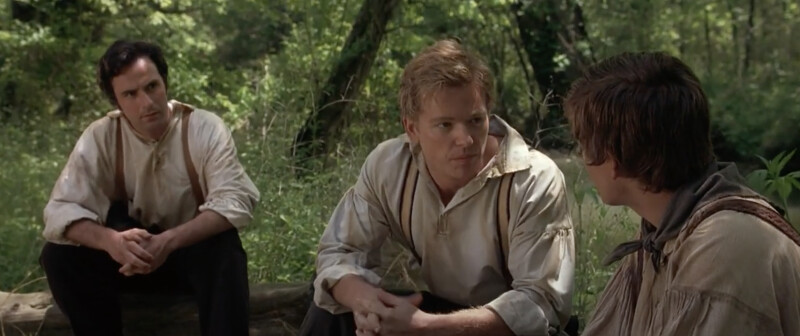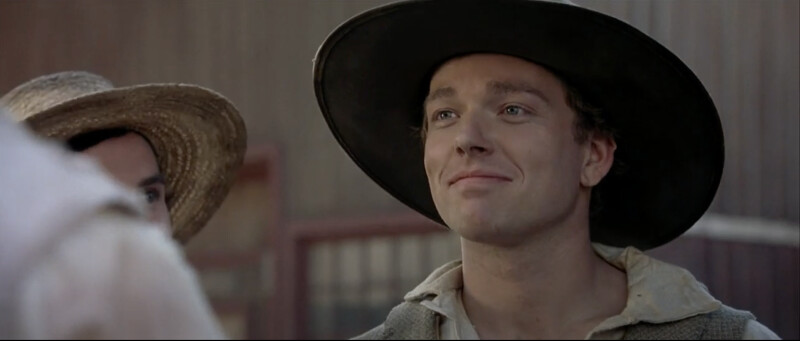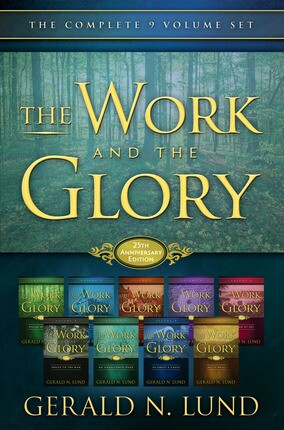When the first volume of The Work and the Glory series was published in 1990, readers instantly fell in love with the Steed family and their adventures in 1800s Palmyra. And the love for those characters continued to grow as author Gerald Lund went on to write eight more volumes that ultimately inspired a successful movie trilogy.
I recently had the chance to interview Lund for the Latter-day Saint blog From the Desk: Learning by Study and Faith. We intended to talk about revelation, but a long series of unexpected twists and turns ended up with a discussion about The Work and the Glory.
It felt like an inspired change of plans. Lund ended up sharing new details about how the series came to be—and still made invaluable insights about how we hear God’s voice. In honor of Pioneer Day, I thought I’d share some of the highlights from our conversation.
1. The Work and the Glory almost never happened
Considering the success of The Work and the Glory, it may be shocking for readers to realize that the project almost never got off the ground.
In the 1980s, Lund, who was a seminary teacher at the time, had just started writing the first book in a New Testament series called The Kingdom and the Crown when his boss presented him with an opportunity to change projects.
“(He) said that a Ricks College (now BYU–Idaho) donor wanted to speak with me about writing a novel version of the history of the Church. I thought about it, but I just didn’t have the time,” Lund explains, so he declined.
2. Lund said no again (and again)
While Lund had turned down the project, that wasn’t the end of the discussion. His boss went back to the donor, a man by the name of Kenneth “Kim” Moe, and explained that Lund wasn’t available. But Moe asked again, and so Lund’s boss returned with another request.
Again, Lund said no. Yet again, his boss persisted. So they went back and forth on the matter until Lund finally gave in—or at least said that he’d consider it.
“I said that I’d take a day to fast and pray about it, but that the answer would likely still be no,” Lund says.
He was wrong.
3. Inspiration changed everything
Lund kept his promise and took the question to the Lord, expecting that God would give him peace of mind to decline the invitation. But that’s not what happened.
“I ended up having my own experience where I learned that writing the story was something the Lord wanted to be a priority in my life,” Lund says.
Looking back on what might have happened had he not fasted and prayed about the matter still makes Lund a little sad.
“Some of those memories are painful,” he said. “The Work and the Glory almost never happened because I got in the Lord’s way.”
But when he received his answer, Lund decided to switch projects and went forward with faith—even when the task seemed incredibly daunting.
4. Lund was called to be a bishop the night he received inspiration to write The Work and the Glory

The inspiration to write The Work and the Glory wasn’t the only surprise Lund would receive that day. His life changed again shortly after he received his answer about writing the series.
“I got a phone call from my stake president,” Lund remembered. “My wife and I went to his office, and he called me to be a bishop. I can remember looking up to heaven and saying, ‘Really? You just told me to do this, and now I’m a bishop?’”
Although the task felt overwhelming, the Lord magnified his abilities to both write and fulfill his calling. “Ironically, about two volumes in, I realized that I was writing faster than before I had been called as bishop,” Lund says. “That was a confirming feeling that I was doing the right thing.”
5. Another church calling also affected Lund’s work on the series
Lund’s tenure as a bishop wouldn’t be the only time he felt he was being pulled between his church calling and writing duties. Once again, his phone brought the news. Lund felt impressed that he was about to receive a calling, but he was confused as to why—after serving as bishop, he had been called as stake president and it didn’t seem likely that his calling would change anytime soon. But this time, the voice on the other end was the personal secretary for President Gordon B. Hinckley.
Two days later, Lund was sustained as Elder Gerald N. Lund, a member of the Second Quorum of the Seventy of The Church of Jesus Christ of Latter-day Saints in the 171st Annual General Conference.
Privately, he admitted to himself that it might be a nail in the coffin for The Work and the Glory. “There goes any hope of writing,” he remembers thinking.
6. Someone else tried to write The Work and the Glory
Lund wasn’t the first person who tried writing The Work and the Glory. Moe, the Ricks College donor who asked for Lund’s help, not only came up with the idea but also attempted to create a draft.
It didn’t go very well, though, and Lund recalls that Moe later told him, “It’s obvious that I can’t do it.” (Moe’s wife jokingly added, “That’s for sure!”)
7. The idea for The Work and the Glory began in an airport
Moe got the idea for The Work and the Glory after he bought a brief version of the Church’s history at the Salt Lake City International Airport. The story was just the introduction to the Church that he needed, and he was fascinated by the lives of the early pioneers. He was eventually baptized and kept reading the book, but thought that a historical fiction version would be useful as a missionary tool.
“Kenneth loved historical fiction,” Lund says. “He kept going back to that thumbnail version of our history, thinking that it would make a good story to share with nonmembers.”
Moe tried writing a draft for years but couldn’t make it work. Finally, he went to a bookstore and purchased every Latter-day Saint fiction book he could find, figuring that if he didn’t have the skill to write the book, he could at least find somebody who did.
“It turns out that he liked my style the best,” said Lund, who at that point had authored books like The Alliance and The Freedom Factor. “That’s when he reached out to my boss in the Church Educational System to see if I would be willing to help.”
8. Lund wasn’t the only person to receive inspiration about The Work and the Glory
Before Lund received heavenly guidance to move forward with the historical series, Moe received inspiration of his own.
The man who started everything in motion admits to being frustrated when Lund initially said no; Moe knew that he couldn’t write the book himself, and He had felt driven to the project by a spiritual feeling. But now the way now seemed blocked by his own version of an impassable Red Sea.
But, as President Russell M. Nelson says, “the Lord loves effort,” and He seemed to be pleased with the steps Moe had already taken.
“One night he had an inspired experience where he learned a couple of things,” says Lund. “First, the Lord wanted him to make a story about the Restoration. Second, he didn’t need to be the one to write it.”
“That’s why he was so persistent when I first said no,” Lund recalls. “It was something he felt inspired to do.”
9. Lund tried to create a media company for The Work and the Glory movies
Lund initially tried to make the film version of The Work and the Glory by himself—he had prior experience writing the script for the seminary video To This End Was I Born. The film performed well within the Church Educational System, so Lund thought he might be able to produce a feature-length movie. So he gathered a small group of friends and tried to create a media company. But they were no more successful producing a film than Moe had been writing a book.
“It was obvious that we were amateurs playing with concepts far beyond our skills,” Lund said. If The Work and the Glory was ever to become a movie, he knew he’d need to find a professional filmmaker.
Scores of entertainers flocked to Lund with requests to purchase the film rights for The Work and the Glory, but it took a long time to find someone who felt like the right fit. He finally settled on Scott Swofford, a Latter-day Saint filmmaker who had impressed Lund with his IMAX productions.
The rest is history. “When he asked, I said yes,” Lund says.
10. Lund was nervous about The Work and the Glory movies
While Latter-day Saint audiences anxiously awaited the release of the first Work and the Glory movie, Lund quietly worried behind the scenes. He was confident that Swofford was the right man for the job, but he also worried about the difficulties of adapting a story with such a grand scope to the big screen.
But when all was said and done, the movie series was a success and surpassed Lund’s expectations. It wasn’t too shabby in terms of profit, either: box office totals for the three films surpassed $6 million, and that wasn't even including DVD sales.

11. Lund sought ecclesiastical permission to produce the movies
The Work and the Glory movies aren’t endorsed by the Church. Neither are the books. But since Lund was serving as a General Authority at the time, he sought permission from Church leadership to produce the movies in an effort to avoid potential implications that it was a Church-made film. Ultimately, the First Presidency gave Lund the green light to move forward as long as the script didn’t raise any red flags (it didn’t).
12. Lund has a lifelong love for studying deeply about revelation—which shows in his books
Lund is fascinated by Joseph Smith and the power of revelation. He’s also intrigued by early Latter-day Saint pioneers who received heavenly light and truth—and then rejected it.
“It’s interesting to see it operating in people who weren’t faithful,” he says. “Six of the original twelve Apostles left, [and] the stake president in Nauvoo swore with an oath that he would not sleep again until he killed the prophet. How did they go from where they began to that?” Lund asks.
This fascination with the choices people have made in Church history is something Lund has thought deeply about ever since he was a little boy. That’s one reason readers find initially rebellious characters like Joshua Steed as compelling as his stalwart brother, Nathan Steed. Sometimes, they respond well to revelation. Other times, they make heartbreaking mistakes.
In other words: they’re just like us.
13. The question Lund wants to ask Joseph Smith
Have you ever wondered what the author of The Work and the Glory would ask the Prophet Joseph Smith about revelation? “I’ve got a list of 500 things,” says Lund. “I would be tempted to ask him to tell me everything he knows about intelligence and the premortal existence.”
“But if I were wise,” Lund continued, “I’d say, ‘Tell me what you have learned about revelation, Joseph.’”
The Work and the Glory: Volumes 1–9 eBook Bundle
Author Gerald N. Lund here masterfully weaves together historical reality and high-powered fiction. In his hands, this combination seems to make the reader an eyewitness to the early scenes of the Restoration, thus deepening one's understanding and appreciation of those momentous events. The well-drawn plot and fictional characters present a moving, gripping story. Here are Benjamin and Mary Ann Steed, devoted to each other as man and wife, yet at odds over religion; Joshua, their volatile son, who rebels and heads for trouble; the sensitive Nathan, their second son, in whom Joseph Smith's message strikes a responsive chord; the beautiful Lydia McBride, who captures the hearts of both Joshua and Nathan.


